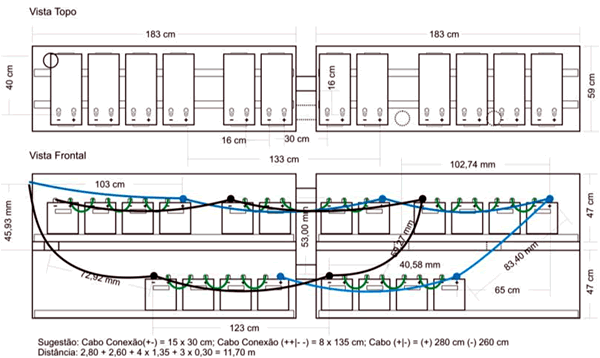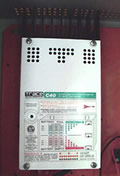The battery bank is the system of energy storage used in the Solar House to provide power at night or on rainy days, when the generation of photovoltaic panels is null or insufficient (low levels of solar irradiance, that is, incident solar radiation). It has been designed to meet, considering the initially charged batteries, a daily consumption of 7.4 kWh for three consecutive days without energy supply from photovoltaic panels or the wind turbine. This corresponds to a storage capacity of useful energy of about 22.3 kWh (Figure 1).

Figure 1 - Battery bank.
The battery bank consists of 20 sealed stationary lead-acid batteries of 150 Ah/12 Volts C20 (with deep discharge cycle) connected on 5 arrays of 4 batteries linked in series connected in parallel, operating at a voltage of 48 Volts CC. The assembly was done with cross-wiring in order to equalize the levels of voltage and current to which the batteries of the bank are submitted (Figure 2).

Figure 2 - Connection of the battery bank.

Figure 3 - Electrical box containing the DC bus, the load controller and transducers for measuring current and voltage connected to the data acquisition system of the Solar House.
The energy generated by the photovoltaic panels goes to the load control system, consisting of drivers loading and unloading. The purpose of load control system is to manage the flow of energy: it stores energy surplus or requests stored energy in the batteries if the power generated by the panels at a given moment is not enough to meet consumption.
The charge controller must disconnect the power source when the batteries reach full charge. This action prevents the batteries from being overcharged and prevents thereby the generation of gas from the electrolysis of water and their overheating, reducing water loss and preserving battery life.
The discharge controller requires at regular intervals energy from batteries so that its life is not compromised by long periods of inactivity, even if the power generation is sufficient to meet consumption. Because batteries are always static, if they were not requested by its controller, its electrolyte fluid decantation could cause the acceleration of chemical wear of the plates of the battery. The discharge controller also prevents voltage in batteries to drop below a certain minimum level of security, to preserve their life, when for some reason (excessive consumption or lack of sunshine) the batteries are not replaced by isolated system generation. Most load controllers are used in solid microprocessed state with load switching relay.

Figure 4 - Detail of battery load Controller used in the Solar House.
The Solar House uses a separate load controller (Figure 4) and a discharge controller integrated with the voltage inverter used.